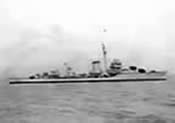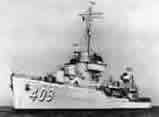The U.S.S Neosho at Coral Sea |
The U.S.S Neosho at Coral Sea
|
 |
 |
 |
USS Sims (DD-409), 1939-1942
The first Sims (DD-409) was laid down on 15 July 1937 by Bath Iron Works Corp., Bath, Maine, launched on 8 April 1939-sponsored by Mrs. William S. Sims and commissioned on 1 August 1939, Lt. Comdr. W. A. Griswold in command.
After shakedown training in the Caribbean and post shakedown availability in the Boston Navy Yard Sims joined the Atlantic Squadron at Norfolk on
2 August 1940. The destroyer operated with the Neutrality Patrol in Caribbean and South Atlantic waters. In November and December 1940, Sims patrolled off Martinique. On 28 May 1941, the ship arrived at Newport, R.I., and began operating from there. She sailed for Iceland on 28 July with an
American task force. In August, the destroyer patrolled the approaches to Iceland. In September and October, the ship made two lengthy North Atlantic patrols. Sims had been attached to Destroyer Squadron (DesRon) 2 since she began making Neutrality Patrols.
With the outbreak of war on 7 December DesRon 2 became part of a
task force (Task Force 17) formed around Yorktown (CV-5). The task force sortied from Norfolk on 16 December 1941 for San Diego. From there, it sailed as part of a convoy taking marines to Samoa, arriving on 23 January, 1942.
At the time, it was believed that the Japanese would attack Samoa to sever Allied communications with Australia. To thwart such a move, a carrier raid against Japanese bases in the Marshall Islands was planned. The Yorktown task force was to strike the islands of Mili, Jaluit, and Makin, while another force centered around Enterprise (CV-6) was to hit Kwajalein, Wotje, and Maloelap.
Task Force 17 departed Samoa on 25 January with Sims in the screen.
At 1105 on the 28th, she sighted an enemy bomber. At 1114, a stick of four bombs fell approximately 1,500 yards astern, straddling the wake of the destroyer. The next day, the two carrier forces and a bombardment group attacked the islands and withdrew.
Sims, with TF 17, sailed from Pearl Harbor on 16 February to attack
Wake Island. Shortly after departing, their sailing orders were changed;
and they proceeded to the Canton Island area.
Canton is a small island on the Honolulu-New Caledonia air route, and
it was thought to be endangered by the Japanese.
By early March, the Japanese had occupied Lae and Salamaua on the north coast of New Guinea. To cheek this drive, a carrier strike was launched on 10 March from Lexington (CV-2) and Yorktown. Sims remained near Rossel Island in the Louisiades with a force of cruisers and destroyers to protect the carriers from enemy surface ships. Sims next operated in the
New Caledonia-Tonga Islands area.
In late April, a Japanese task force was assembled to win control of the
Coral Sea area and thereby isolate Australia. This consisted of a covering group to protect landing forces on Tulagi and Port Moresby and a striking force to eliminate Allied shipping in the Coral Sea. The light carrier, Shoho, was attached to the covering force, and the big new carriers, Shokaku and Zuikaku, were the striking force under command of Admiral Takagi. The American ships were divided into task forces centered around Lexington and Yorktown, Sims was ordered to escort oiler, Neosho (AO23). The task force refueled on 5 and 6 May and then detached Neosho and Sims to
continue to the next fueling point.
On the morning of 7 May, a search plane from the Japanese striking force sighted the oiler and destroyer and reported them to Admiral Takagi as a carrier and a cruiser. Takagi ordered an all-out attack. At 0930 15 high level bombers attacked the two ships but did no damage. At 1038, 10 attacked the destroyer, but skillful maneuvering evaded the nine bombs that were dropped. A third attack against the two ships by 36 dive bombers was devastating. Neosho was soon a blazing wreck as the result of seven direct hits and one plane that dived into her.
Sims was attacked from all directions. The destroyer defended herself as best she could. Three 500-pound bombs hit the destroyer. Two exploded in the engine room; and, within minutes, the ship buckled amidships and began to sink, stern first. As Sims slid beneath the waves, there was a tremendous explosion that raised what was left of the ship almost 15 feet out of the water. Chief R.J. Dicken, in a damaged whaleboat, picked up 14 other survivors.
They remained with Neosho, still afloat despite severe damage,
until they were rescued by Henley (DD-391) on 11 May.
Sims was struck from the Navy list on 24 June 1942.
Information and images from delsjourney.com
Note: On May 8, 1942, the Headline above brought the Coral Sea Battle to the
American people. On June 15, 1942, the article tells of the local toll it was taking.
On this Hackensack wall unit, it was a direct hit! One of the most heroic and untold stories of this battle will unfold through the links below. The important facts are Alfred A. Sanzari was aboard the destroyer U.S.S. Sims which was to defend the tanker Neosho of whom Tom Cameron was on. Both men went to Hackensack High School and are on the wall. Tom Cameron was on the Neosho in “the thick of it,” as the article states when Pearl Harbor was hit. How thick? Well, the Neosho was between the Oklahoma and California on Battleship row.
The article holds out hope, but history proves otherwise.
Both men perished as a result of the Battle of the Coral Sea.
Written by:
Bob Meli
2009
Background image of the U.S.S. Neosho refueling the USS Yorktown shortly before the Battle of Coral Sea obtained from: |